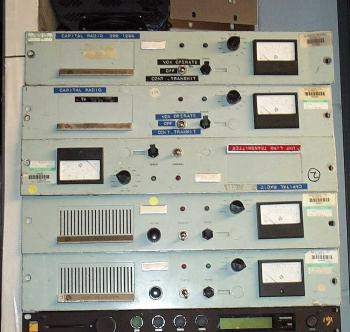Capital Radio - The analogue OB links saga
The early days - landlines
During the early days of Capital Radio, all major outside broadcasts were linked back to the studios by temporary 'private wire' analogue landline connections. These used spare standard telephone cables but were fixed, point to point, and separate from the Public Service Telephone Network. They were offered at a fixed price irrespective of the difficulty of providing them, even to the extent of installing a temporary overhead multi-pair cable, on specially erected telephone poles, to the far side of the grounds at Knebworth House for a concert. The usual service provision order was for a single, fixed, standard telephone type line ('control line') for programme liaison and co-ordination, such as arranging the timing of commercial breaks (referred to as 'talkback'), and two 'music lines'. The latter had their frequency response extended to, typically, 50Hz to 12kHz, often better, at low distortion. Although provided as two 'mono' lines and so not specified for the tight differential phase characteristics needed for stereo operation they were, in practice, very satisfactory in most cases. With stereo listeners in a minority in the early days, on the odd occasion when stereo performance was unsatisfactory, for instance because the two lines were not co-routed, it was considered acceptable to broadcast the OB in mono and use the second music line as a standby feed. The 19kHz stereo pilot tone transmitted on 95.8MHz was switched off for the duration, as for all programmes with wholly mono content at that time.During the run-up to privatisation of the telephone service two basic changes caused problems. Firstly the threat of industrial action relating to privatisation issues prejudiced the reliability of the provision of temporary private wire services. One important OB was nearly lost because of this. Secondly the 'one price fits all' policy was abandoned in favour of an individual order pricing policy, which in most cases resulted in considerably higher charges. Stereo matched pairs of music lines became generally available, at a substantial premium over the cost of two mono music lines, and the incidence of the performance of a pair of mono lines being unsatisfactory for stereo use mysteriously escalated. Fortunately BBC R&D Dept. had designed a 'magic box' which was capable of compensating a pair of mono music lines for just about any combination of differential phase and delay characteristics which could be thrown at it, and one of these was duly purchased.
And then - radio links
For the spontaneous links needed for news reporting within the London area Capital had two radio cars equipped with standard VHF Private Mobile Radio (now known as Private Business Radio) transceivers (PYE 'Europa' MF25FM) for communications. For the (mono) programme link PYE L470 UHF equipment was used, and there were three pick-up points available in the London area which had been generously provided with two receivers and two music lines each, allowing the two radio cars to operate simultaneously if needed.Although absolutely invaluable for the purpose for which it was intended, the radio car radio link system was a lightly used resource. A management decision was taken to bring the reliability and cost of temporary OB links more under Capital's control by transferring one-off OB links within the London area from private wire to radio links, sharing the radio car frequencies, wherever practical. Regular OB's such as the Saturday night disco programme used semi-permanent lines which were generally left intact by the service provider and simply de-activated by removing a 'jumper' link outside booked times so were less problematic.
The version of the L470 originally fitted to the radio cars was intended for the audio frequency range of 40Hz - 10kHz but retained the PMR industry standard phase modulation, produced directly in the transmitters by a phase modulator. The resultant 6dB/octave deviation pre-emphasis over around 8 octaves gave excellent signal to noise ratio from the matching receiver but meant the audio level which could be sent to the transmitter without subjectively unacceptable distortion was very difficult to judge on speech and was certainly going to be unacceptable for music. The transmitters' phase modulators were retained but Improvements to the audio stages included frequency compensation to give resultant FM with 75μS pre-emphasis and extending the audio frequency response to 40Hz - 12kHz. Improvements to the receivers' audio stages included changing the de-emphasis to 75μS to match. Additional transmitters for use on a transportable basis were purchased and modified, and the IBA, who were guardians of the ILR radio link sub-bands at the time, co-operated by making a third UHF link frequency available. For major OB's such as the London Marathon it was then possible to present the sustaining programme in stereo using a pair of channels while inserting speech reports from different parts of the course linked via a third channel. The 'flying eye' traffic spotter plane operated on its own dedicated link channels so could also contribute live reports during such OB's - no doubt modest by BBC national service standards but quite adventurous for a local radio station.

Spare PYE L470 transmitters and receivers
It was decided that as a final major improvement noise reduction would be added and comparisons between three analogue compander systems were made. Dolby 'A', already in use with studio analogue reel to reel tape machines, was ruled out as there was a danger the noise level on some links would exceed the noise reduction threshold. Dbx, for Capital's application, suffered from side effects including 'bass pumping' on music while Telcom C4, a four frequency band 1.5:1 system, gave subjectively acceptable results with a good improvement in link signal to noise and was selected.

Telefunken telcom C4 units in the lines room at Leicester Square
